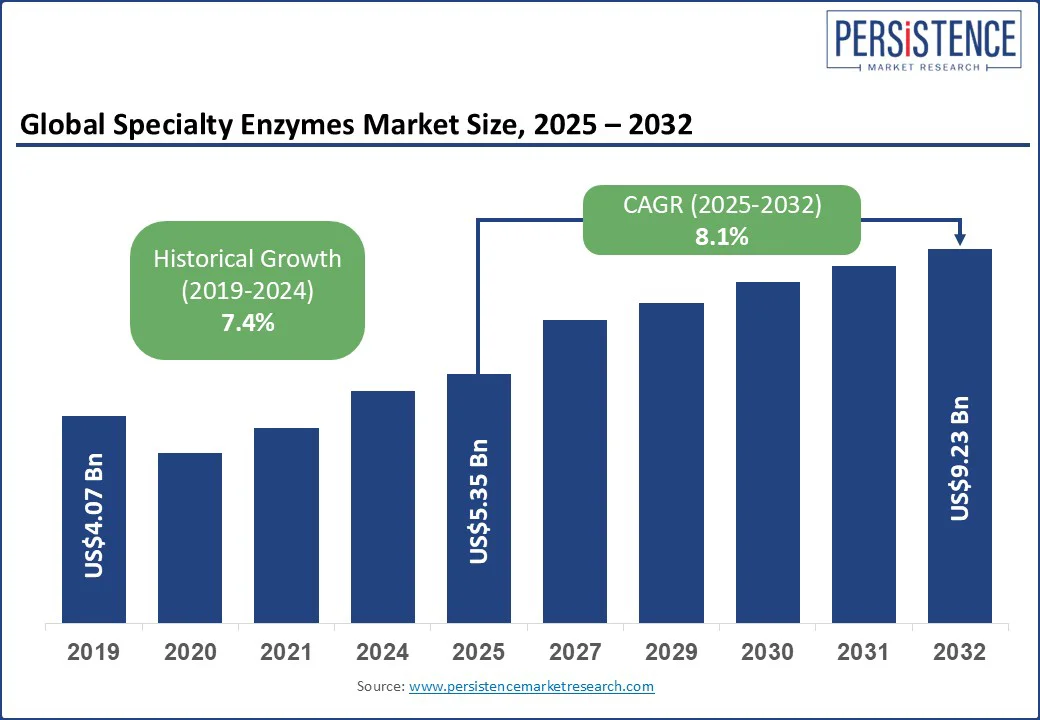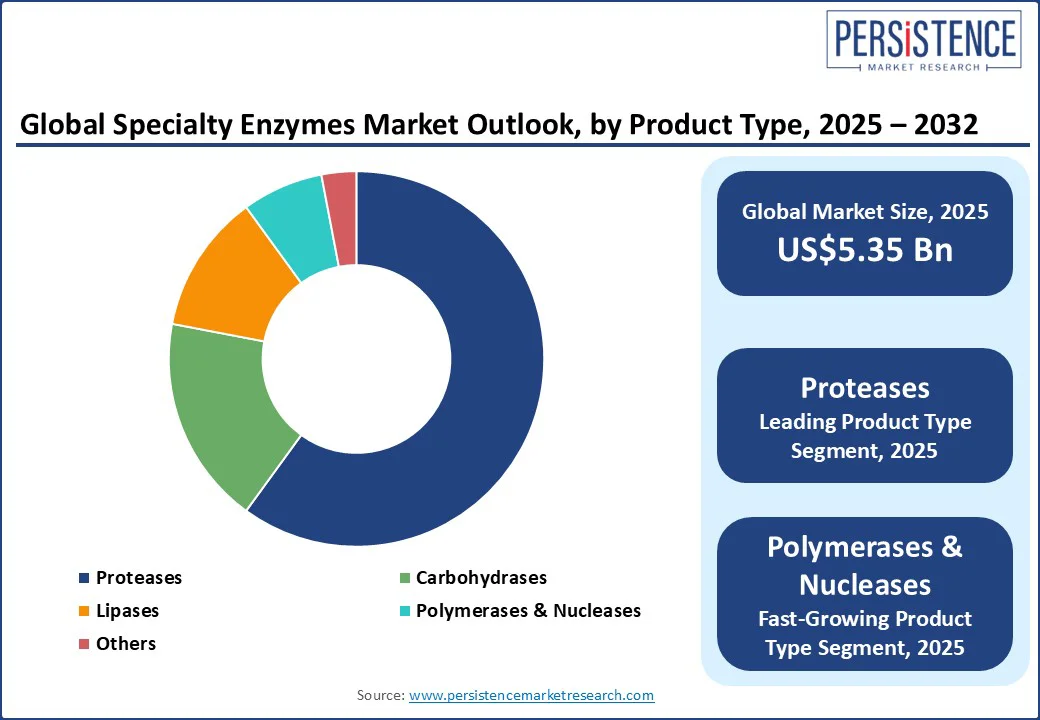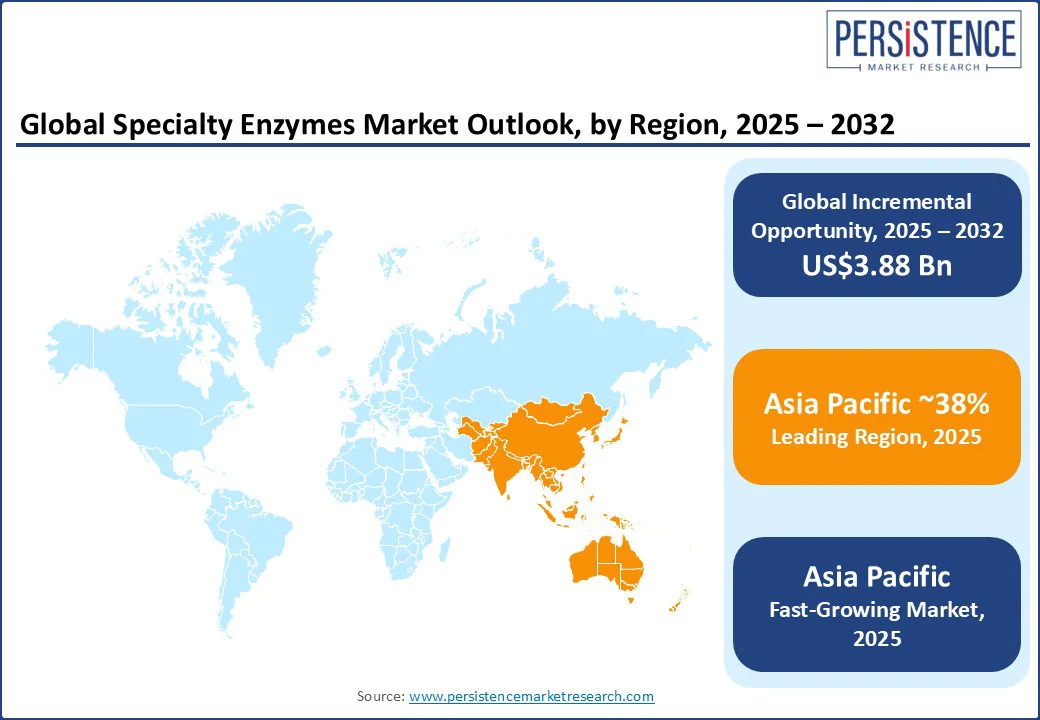ID: PMRREP35579| 193 Pages | 25 Aug 2025 | Format: PDF, Excel, PPT* | Chemicals and Materials

The global specialty enzymes market size is projected to rise from US$5.35 Bn in 2025 to US$9.23 Bn by 2032. It is anticipated to witness a CAGR of 8.1% during the forecast period from 2025 to 2032.
The market growth is driven by the increasing demand for highly specific biocatalysts used across diverse industries such as pharmaceuticals, diagnostics, food processing, and biotechnology.
Specialty enzymes are unique proteins that catalyze precise biochemical reactions, enabling innovative solutions in drug development, disease diagnosis, sustainable industrial processes, and high-value food production. Their importance lies in their ability to offer enhanced efficiency, specificity, and eco-friendly alternatives to traditional chemical processes.
In addition, the rising prevalence of chronic diseases globally demands the development of advanced pharmaceutical solutions, promising biopharmaceutical R&D investments, and expanding applications of these proteins in diagnostics requiring high specificity and sensitivity.
Sustainability is another crucial trend, with industries such as food, textiles, and biofuels increasingly adopting greener enzymatic processes to reduce their carbon footprint. The development of customized enzymes through microbial sourcing and enzyme engineering is opening new opportunities, particularly in precision medicine and environmentally conscious manufacturing.
Key Industry Highlights:

|
Global Market Attribute |
Key Insights |
|
Specialty Enzymes Market Size (2025E) |
US$5.35 Bn |
|
Market Value Forecast (2032F) |
US$9.23 Bn |
|
Projected Growth (CAGR 2025 to 2032) |
8.1% |
|
Historical Market Growth (CAGR 2019 to 2024) |
7.4% |
Innovations in the biopharmaceutical sector are driving the growth of specialty enzymes market. In biopharma R&D, these enzymes play a crucial role as biocatalysts in the production of advanced therapeutics like monoclonal antibodies, gene therapies, and vaccines. Some of the largest pharmaceutical companies have already forayed into this space.
For instance, in 2021, Novozymes and Novo Nordisk collaborated to develop specialty enzymes for formulating regenerative medicines. This surge is fueled by increasing chronic and lifestyle-related diseases worldwide, especially among aging populations, which has intensified the demand for advanced and highly specific pharmaceutical enzymes capable of precision bioprocessing.
Breakthroughs in enzyme engineering and microbial sourcing have unlocked new enzyme variants with enhanced stability and efficacy, supporting sustainable and eco-friendly production processes that align with global green chemistry initiatives.
A recent report by the U.K. BioIndustry Association (BIA) revealed that the country’s biotech sector attracted US$810 Mn in venture capital investments in 2024, highlighting the massive potential in enzyme-based innovations. The cascading effect of this biopharma-driven enzyme demand creates expansive opportunities in diagnostics, research biotechnology, and industrial applications.
A major obstacle hindering the market is the high production costs of these biocatalysts, coupled with the complex regulatory hurdles companies must navigate to develop and launch their products. Unlike bulk industrial enzymes that are produced at large scales, specialty enzymes require meticulous purification, stabilization, and quality control to meet the exacting standards for pharmaceutical, diagnostic, and food applications.
This leads to elevated expenses involving advanced technologies such as protein engineering, recombinant DNA methods, and sophisticated fermentation systems, which are often beyond the reach of small and medium enterprises.
For example, the expensive synthesis processes and rigorous purification steps increase the final product price, limiting the adoption of these proteins in price-sensitive emerging markets. Adding to this burden are the regulatory hurdles placed by agencies such as the USFDA and EMA, including complex approval pathways and compliance demands, which firms must navigate to gain market entry.
Market players can capitalize on the increasing momentum in developing and deploying customized enzyme platforms. These platforms utilize synthetic biology and advanced computational methods to engineer highly specialized, high-performance enzymes, tailored for a wide range of industrial and pharmaceutical applications.
This approach addresses the growing demand for precision biocatalysts in sectors ranging from pharmaceuticals, where enzymes accelerate drug discovery and bioprocessing, to food & beverage, where they enhance quality and sustainability.
For example, Ginkgo Bioworks' 2022 launch of its Ginkgo Enzyme Services demonstrates how integrating machine learning with genomic databases accelerates enzyme optimization, helping clients improve catalytic efficiency, stability, and specificity for novel applications.
The advent of these platforms has not only facilitated enzyme scalability but has also helped companies align their strategies with the broader industry shift toward green chemistry and sustainability.
Proteases are expected to dominate with a revenue share of approximately 60% in 2025, owing to their pivotal role in pharmaceutical manufacturing, where they catalyze protein modification processes critical for developing biopharmaceuticals such as monoclonal antibodies and vaccines.
The increased prevalence of chronic diseases worldwide has accelerated pharmaceutical demand, boosting protease utilization for efficient drug development and production.
Proteases are also extensively applied in the food & beverage sector for protein hydrolysis to enhance food texture and nutritional profiles. In the consumer goods sector, these enzymes are used in detergents to improve stain removal at lower temperatures. For instance, the surge in enzyme-based eco-friendly detergent formulations has been substantiated with companies such as Novozymes innovating protease variants tailored for sustainability.
The polymerases & nucleases sub-segment is set to grow the fastest during 2025 - 2032. The explosive expansion of R&D activities in biotechnology, diagnostics, and molecular biology is the core growth determinant for these specialty enzymes. Central for nucleic acid amplification, gene sequencing, and precision diagnostics, polymerases & nucleases are vital for high-throughput genomic testing, personalized medicine, and cutting-edge research tools.
The COVID-19 pandemic and ongoing genomic research have further heightened their demand, as reflected by rapid advancements in next-generation sequencing and CRISPR gene editing technologies, where these enzymes are crucial. This niche yet rapidly growing sub-segment aligns seamlessly with the increasing focus on precision medicine and diagnostic accuracy, offering promising opportunities for market expansion.
Liquid specialty enzymes are slated to lead with a commanding 67.2% revenue share in 2025. Their dominance is attributable to their superior solubility, ease of formulation, and immediate activity readiness in diverse industrial and pharmaceutical processes. They are crucial in sectors such as food & beverage for juice clarification, dairy fermentation, and starch conversion, as well as in the textile industry.
The pharmaceutical industry increasingly favors liquid enzymes for biocatalysis and drug manufacturing due to their rapid action and compatibility with continuous production systems. Recent advancements in enzyme stabilization and refrigerated supply chains have solidified their market leadership. Innovations in enzyme stabilization technology have significantly extended the shelf life of liquid enzymes, driving increased demand across fast-growing emerging markets.
The solid form of specialty enzymes is also gaining strong traction due to its ease of handling, longer shelf stability, and cost-efficient storage and transportation, particularly in regions with limited cold chain infrastructure. Solid enzyme powders and granules are preferred in agricultural, animal feed, and industrial sectors where on-site enzyme activation, or during processing, is both desirable and possible.
Innovations in microencapsulation and freeze-drying techniques have enhanced solid enzyme stability and activity, reducing degradation and enabling targeted release. Solid enzymes are also increasingly utilized in high-value pharmaceutical applications that require controlled dosing and consistent enzyme performance.

With nearly 38% of the market share, Asia Pacific is not only poised to lead in 2025 but also projected to be the fastest-growing region through 2032. The market is driven by the exponential growth of the pharmaceutical and biotechnology sectors in the region, especially in China and India. This dynamism is fueled by a rapidly strengthening healthcare infrastructure, wider financial allocation for research & development ventures, and an increasing demand for advanced diagnostics and biopharmaceutical manufacturing.
India, contributing over 20% of the global generic drug supply, consumes a significant amount of specialty enzymes in drug production, bolstered by government initiatives supporting biotechnology innovation.
China is also known to leverage specialty enzymes extensively for food processing, particularly baking, where enzyme use improves dough quality and shelf life. Apart from this, the regional market benefits from rising awareness among consumers regarding health and wellness, further expanding enzyme applications in nutraceuticals and sustainable industrial processes.
North America upholds its status as a mature market, primarily on account of the robust functioning of the biotechnology and pharmaceutical industries in the U.S. Consistently high R&D spending and a well-established commercial production of specialty enzymes used in drug manufacturing, diagnostics, and research biotechnology are factors that favor this regional market.
The growing trend toward personalized medicine and enzyme-based therapeutics is driving the demand for highly specific biocatalysts. Companies in the region are also focusing intensely on enzyme optimization for pharmaceuticals and green industrial processes, supported by substantial venture capital investments and government funding in enzyme technologies. The expanding food & beverage sector is also actively adopting enzymes for sustainable production and product quality enhancement.
In Europe, Germany, U.K., France, and Italy are major markets with a high reliance on the pharmaceutical, medicinal, and cosmetic industries that extensively use specialty enzymes. The regional market is benefiting from organized regulatory frameworks promoting healthcare innovations, driving the demand for enzymes in biopharmaceutical manufacturing and research applications.
Investments in biotechnology startups and enzyme engineering frontiers contribute to the progress in enzyme diversification and sustainable enzymatic processes. Europe's dyeing and textile industries are leveraging specialty enzymes for eco-friendly solutions, aligning with the European Union's strong policies aimed at reducing carbon footprints and promoting green chemistry.

The global specialty enzymes market is characterized by ongoing innovation, strategic partnerships, and ambitious geographic expansion. Key players, such as Novozymes, DuPont, BASF, and DSM, are investing heavily in enzyme engineering, leveraging AI and synthetic biology to develop tailored solutions for pharmaceutical, diagnostic, and industrial applications.
Increase in venture capital funding, especially in smaller companies and biotech startups in Asia Pacific, has bolstered R&D capacities and aided market growth. Sustainability considerations in the chemicals and pharmaceutical industries and advancements in digital manufacturing have enhanced efficiency and also enabled compliance with environmental regulations.
The specialty enzymes market is projected to reach US$ 5.35 Bn in 2025.
Innovations in the biopharmaceutical sector and breakthroughs in enzyme engineering and microbial sourcing are driving the market.
The specialty enzymes market is poised to witness a CAGR of 8.1% from 2025 to 2032.
The development and deployment of customized enzyme development platforms and the growing demand for precision biocatalysts in sectors ranging from pharmaceuticals to food & beverage are key market opportunities.
Novozymes A/S, DuPont de Nemours, Inc., and BASF SE are some leading players.
|
Report Attribute |
Details |
|
Historical Data/Actuals |
2019 - 2024 |
|
Forecast Period |
2025 - 2032 |
|
Units |
Value: US$ Bn |
|
Geographical Coverage |
|
|
Segmental Coverage |
|
|
Competitive Analysis |
|
|
Report Highlights |
|
|
Customization and Pricing |
Available upon request |
By Product Type
By Source
By Form
By Application
By Region
Delivery Timelines
For more information on this report and its delivery timelines please get in touch with our sales team.
About Author